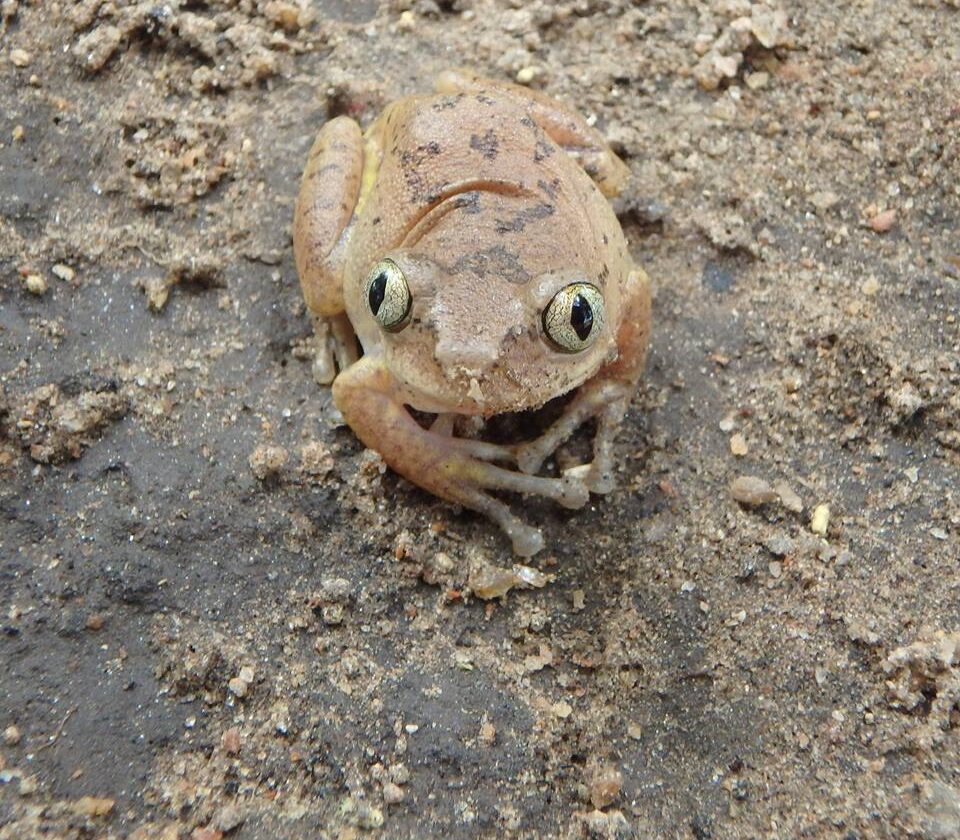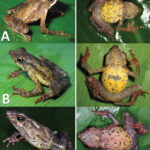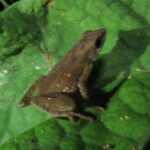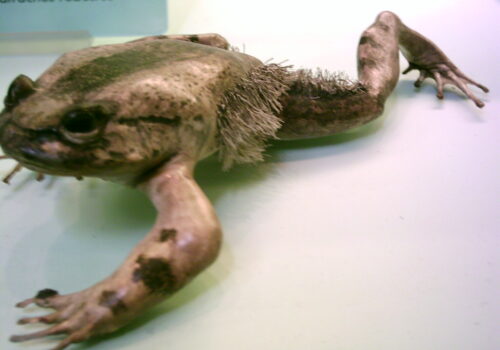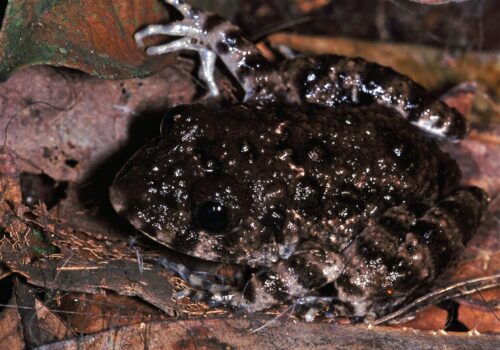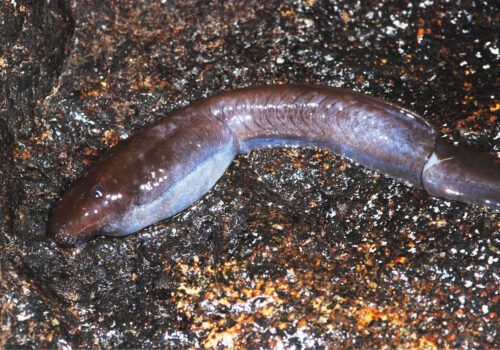Leptopelis argenteus: The Enchanting Silver Tree Frog of East Africa’s Forests#
In the shadowy depths of East Africa’s lush, highland rainforests, among towering evergreen trees draped in moss and silver fog, a delicate silver-grey amphibian emerges quietly every dusk. This enigmatic tree dweller is none other than Leptopelis argenteus, a species of frog commonly referred to as the Silver Tree Frog or the Silvery Forest Treefrog. Smaller than the palm of your hand yet utterly captivating in its understated magnificence, this tree frog holds a special place in the intricate web of life in its woodland home. Though secretive and often unseen, its twilight chorus and unique adaptability exemplify the delicate harmony and interconnectedness of rainforest ecosystems, reminding us all of why these little creatures deserve our attention and conservation efforts.
Taxonomy and Classification#
Scientifically known as Leptopelis argenteus, this frog belongs to the Arthroleptidae family, within the genus Leptopelis, recognized for their tree-dwelling, arboreal species. Originally described in 1893 by the British zoologist George Albert Boulenger, Leptopelis argenteus quickly captured the interest and imagination of biologists due to its subtle beauty and intriguing behavior.
The genus Leptopelis, comprising several dozen species known collectively as forest and savannah tree frogs, extends throughout sub-Saharan Africa. Specifically, the Silver Tree Frog is closely related to other highland-adapted members of its genus, such as Leptopelis vermiculatus and Leptopelis karissimbensis, each adapted uniquely to their localized habitats and elevation gradients across the continent.
Natural Habitat#
Leptopelis argenteus is primarily found within the humid, montane forests and lush upland thickets surrounding East Africa’s famed valley and highland ecosystems. Its known range is predominantly concentrated in countries such as Tanzania, Kenya, Rwanda, Uganda, and Burundi. Rich in diversity and dominated by dense woodlands punctuated by crystal-clear mountain streams, misty swamps, and prolific leaf litter, this area provides the optimal combination of moisture, shelter, and abundant insect prey required by this arboreal species.
A Life in Canopy Shadows#
Though occasionally descending to lower vegetation layers or near forest streams during breeding seasons, this shy amphibian primarily occupies branches, leaves, and vines of mid-to-high canopy regions. The varied canopy structure, thick vegetation, and plentiful epiphytes offer safe harbor from predators, ample microhabitats to avoid competition, and the relative stability of temperature and humidity required by this moisture-sensitive creature.
The Ideal Microclimate#
The highland forests inhabited by Leptopelis argenteus feature cool temperatures, frequent mists, and considerable precipitation, often exceeding 1,200 mm annually. This consistent moisture is vital for maintaining the hydrated skin of tree frogs and provides plentiful spawning sites during their breeding period. Rainy seasons transform these forests into vibrant breeding grounds, resonating loudly with nightly choruses and creating ideal conditions for successful mating and larval development.
Physical Characteristics#
Though relatively small—typically ranging just 3 to 5 centimeters (1.2 to 2 inches)—Leptopelis argenteus showcases a unique beauty that belies its petite stature. Their slender bodies and elongated limbs reflect adaptations essential for their arboreal lifestyle, allowing agile leaps and precise landings on even the most delicate forest vegetation.
A Cloak of Subtle Silver#
Its coloration—a striking yet discreet silver-grey to pale green—lends the frog its common name and acts effectively as camouflage amidst morning mists and the pale moonlight filtering into the treetops. Tiny, intricate patterns of faint mottling adorn their smooth skin, further blending effortlessly with bark and lichen-covered leaves. Their large, expressive eyes, often golden or bronze-colored, provide exceptional night vision necessary for their nocturnal activities.
Adaptations for Survival#
The frog’s toes possess elaborate suction-like pads, enabling remarkable climbing skills crucial for life at elevation. Additionally, their moist, permeable skin serves critical roles in fluctuating gas exchange and hydration maintenance, rendering them highly sensitive ecological indicators that reflect the overall health of their forested habitat.
Behavior and Life Cycle#
Come twilight, as the forest transitions from day to night, Leptopelis argenteus embarks on its twilight journey. Driven by the innate need to feed, breed, and avoid predation, these frogs exhibit remarkable nocturnal adaptations and fascinating behavioral patterns.
Masters of the Hunt#
The diet of Silver Tree Frogs primarily consists of insects, including moths, beetles, ants, and flies. Employing a sit-and-wait hunting strategy, these modest hunters often perch motionless upon a leaf or branch, striking swiftly with their sticky tongues the moment unsuspecting prey ventures close. This ambush strategy, effective and energetically economical, exemplifies precision and patience.
The Song of the Silver Frog#
One of the most enchanting details of their behavior is their evocative mating call, a series of subtle yet rhythmic, melodic clicks or gentle trills that echo through dense vegetation during rainy seasons. Male frogs use these elegant choruses to attract potential mates. Females, whose selective behavior crucially guides mate choice, gravitate towards calls signifying strong genetic fitness and optimal health.
The Art of Amphibian Parenthood#
Following successful courtship, female Silver Tree Frogs typically lay modest clusters of jelly-like eggs adhered carefully to foliage suspended above shallow pools and forest streams. Upon hatching, tadpoles drop gently into the water, commencing their aquatic stage. Over several weeks, the tiny tadpoles grow, undergoing metamorphosis into juvenile frogs that eventually make their precarious first ascent into canopy living.
Ecological Role#
Small yet ecologically crucial, Silver Tree Frogs serve as both predator and prey, profoundly influencing the careful balance maintained within their rich habitat.
An Essential Predator#
Adult frogs provide essential ecosystem control, feeding regularly on numerous insect species, significantly curbing populations of pests like mosquitoes. In doing so, they indirectly benefit larger mammals, birds, and even human populations by helping control pests and disease vectors.
A Delicate Link in the Food Chain#
In turn, the Silver Tree Frog’s diminutive size renders them vulnerable to a multitude of predators. Birds, snakes, and small mammals depend on healthy frog populations as a steady food supply. This delicate position within the ecosystem magnifies the importance of maintaining stable populations of Leptopelis argenteus.
Threats and Conservation Status#
The Silver Tree Frog currently holds a conservation status labeled as Least Concern by the International Union for Conservation of Nature (IUCN). Nevertheless, increasing pressures from habitat loss due to agricultural expansion, urbanization, deforestation, and climate change could imperil their future.
Habitat fragmentation and pollution directly reduce viable habitats and breeding sites, controlling the long-term survival of amphibian populations. Amphibians are remarkably sensitive ecological indicators; population fluctuations and habitat loss among species such as Leptopelis argenteus signify broader environmental shifts and should never be ignored.
Hope through Conservation Action#
Multiple conservation initiatives periodically focus on highland rainforest protection in East Africa, safeguarding habitats essential for maintaining healthy amphibian and wildlife populations. Education and awareness programs continue to underscore the importance of amphibians. Encouraging interest and active participation from local communities, wildlife enthusiasts, and researchers ensures continued protective efforts for important species like the Silver Tree Frog.
Cultural and Scientific Significance#
Although not steeped in widespread folklore, the unique silver sheen, delicate calls, and nocturnal lifestyle continue to captivate researchers and conservationists alike. Over time, the Silver Tree Frog has elevated attention to amphibian conservation, serving as a charismatic representative of the diverse tree frog genus Leptopelis.
Conclusion#
The Silver Tree Frog, Leptopelis argenteus, may easily be overlooked amidst East Africa’s biodiversity; however, it embodies a fascinating blend of adaptation, resilience, and ecological significance. By understanding, appreciating, and safeguarding such delicate but important amphibians, we affirm our commitment not only to frogs but to the richness, wonder, and interconnectedness of nature itself. Consider exploring further, supporting local conservation groups, and lending your voice in defense of these silvery guardians of the East African highland forests.

